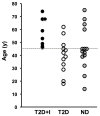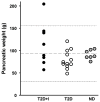Reanalysis of study of pancreatic effects of incretin therapy: methodological deficiencies
- PMID: 24400596
- PMCID: PMC5678976
- DOI: 10.1111/dom.12257
Reanalysis of study of pancreatic effects of incretin therapy: methodological deficiencies
Abstract
A recently published study by Butler et al. concluded that incretin treatment had adverse effects on the human type 2 diabetic pancreas including 'a marked expansion of the exocrine and endocrine pancreatic compartments, the former being accompanied by increased proliferation and dysplasia and the latter by α-cell hyperplasia with the potential for evolution into neuroendocrine tumours'. Incretin therapy has become widely used for type 2 diabetes, so these conclusions have instigated major concerns with regard to patient safety. We reassessed both the clinical case information and virtual microscopy images of the same 34 cases that were used in the Butler study as well as Network for Pancreatic Organ Donation (nPOD) cases that were not included. Whereas we would like to stress that it is important to investigate in depth any indication that incretin treatment may lead to inflammation or dysplasia in the pancreas, we find that the data presented in the Butler paper have serious methodological deficiencies that preclude any meaningful conclusions.
Keywords: incretin therapy; islets; type 2 diabetes.
© 2014 John Wiley & Sons Ltd.
Figures





Comment on
-
Marked expansion of exocrine and endocrine pancreas with incretin therapy in humans with increased exocrine pancreas dysplasia and the potential for glucagon-producing neuroendocrine tumors.Diabetes. 2013 Jul;62(7):2595-604. doi: 10.2337/db12-1686. Epub 2013 Mar 22. Diabetes. 2013. PMID: 23524641 Free PMC article.
References
-
- Butler AE, Campbell-Thompson M, Gurlo T, Dawson DW, Atkinson M, Butler PC. Marked expansion of exocrine and endocrine pancreas with incretin therapy in humans with increased exocrine pancreas dysplasia and the potential for glucagon-producing neuroendocrine tumors. Diabetes. 2013;62:2595–2604. - PMC - PubMed
-
- Campbell-Thompson M, Wasserfall C, Kaddis J, Albanese-O’Neill A, Staeva T, Nierras C, Moraski J, Rowe P, Gianani R, Eisenbarth G, Crawford J, Schatz D, Pugliese A, Atkinson M. Network for Pancreatic Organ Donors with Diabetes (nPOD): developing a tissue biobank for type 1 diabetes. Diabetes Metab Res Rev. 2012;28:608–617. - PMC - PubMed
-
- Cohen D. Has pancreatic damage from glucagon suppressing diabetes drugs been underplayed? Bmj. 2013;346:f3680. - PubMed
Publication types
MeSH terms
Substances
Grants and funding
LinkOut - more resources
Full Text Sources
Other Literature Sources
Medical

